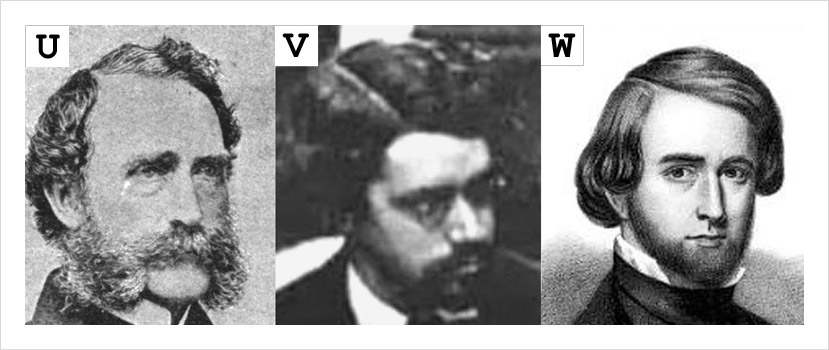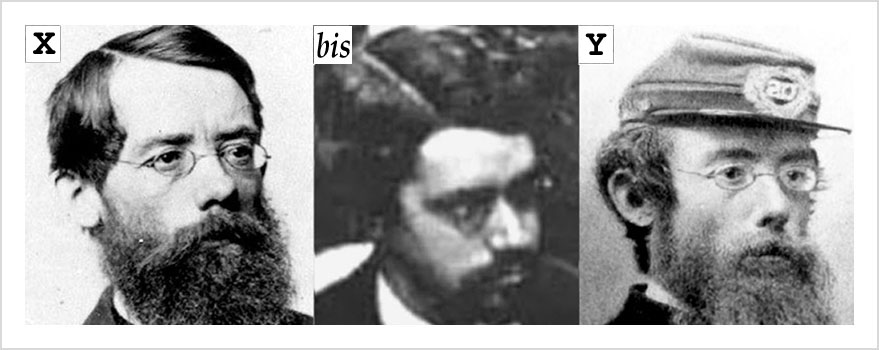

Views of William T. G. Morton: U.) Morton, detail from Macfadden (1885), How Success is Won. V.) Detail of Figure 5 in EDD No. 1, the "reenactment" daguerreotype – misidentified as Morton in historical accounts, but identified by the author/artist as Dalton. W.) Detail of frontispiece from Edward Warren (1847) "Some Account of the Letheon: Or, Who is the Discoverer?".
The legacy attributions of Figure 5 purporting the identity of Morton are tenuous. As the etherizer in artistic portrayals of the Abbott operation he is invariably depicted center stage, in command, and towering over the doctors in the arena, but he also appears quite tall in the family photographs that I have seen. And then there is his description as "tall, handsome and of engaging manners" found in a 1905 memoir written by his son, Dr. William James Morton. These physical assessments contrast markedly with the unimposing short stature presented by Figure 5 in the "reenactment" daguerrotype. The naming Morton convention is also troubled by the appearance of glasses on Figure 5 that may or may not be caused by artifacts in the photographic substrate, giving rise to the proposition that the etherizer is actually John Call Dalton. For their attribution of Morton, Lowry & Lowry referenced a holograph notation attached to a record in the archives of MGH that names him as the etherizer in the daguerreotype.(53) Their more solid reference is the portrait shown in the panel above (Figure W) that appeared as the frontispiece to the rare First-thus edition of Edward Warren's pamphlet published in defense of Morton.(54 »») Lowry & Lowry aptly describe the resemblance to Morton as "striking," but without further documentation to support their claim, an attribution for the young House-apothecary Dalton is ineluctible.

Views of John Call Dalton: X.) Detail of portrait pulled from the internet. Published in Walsh (1909), "History of medicine in New York" ; vol. 2, plate facing p. 433. V bis.) Dalton, age 21 – detail of Figure 5 in EDD No. 1. Y.) Detail of frontispiece (reversed) in Dalton's memoir of his Civil War experiences, age c36. Printed privately, 1892 ; phot. by James Wallace Black.
Adherents to the reenactment scenario will not be easily disabused from the consensus view that Morton is the etherizer in the daguerreotype. To their credit, the Lowrys included the following notation on Morton: "On discovering the paper copy of this daguerreotype [EDD No. 1], Holman identified the anesthetist not as Morton, but as a stand-in who was 'by tradition, an orderly who resembled him closely' (Prints at Holman's, p. 2)."(55) In 1934, Dr. Edward S. Hawes began consigning the photographs from his father's estate to Holman's Print Shop in Boston, among which included paper prints of the "reenactment" daguerreotype that Hawes had made. It's highly unlikely that the Holmans would have made the claim de novo, and more likely it came from a notation in Hawes's hand, on or attached to the print, or archival documentation furnished by his son. The Holmans were not alone in disavowing the Morton connection. Richard J. Wolfe, whose monograph on Morton is the preeminent source on the life of that "Tarnished Idol," glaringly omits the name of Morton among the identities he assigns to the "reenactment" daguerreotype, referring to Figure 5 as merely "the person holding the ether inhaler" (op. cit., 2001 ; p. xi). Dr. Haridas also questioned the attribution and stated there was "no similarity with known photographs of Morton" and held "doubts that this person is Morton."(56) I would add that I was unable to find a description or a picture of Morton wearing spectacles such as those Figure 5 seems to be wearing. Below is Dr. Slade's description of Morton's habitus that contrasts sharply with the MGH professional uniform of a frock coat and custom cravat worn by Figure 5:
| "Thereupon, Morton, a man of commanding figure and appearance, very erect, and dressed, as he usually was, in a stylish fashion peculiar to himself, consisting of a blue frock-coat with brass buttons, a large and elegant scarf which completely filled up the open front of the waistcoat "gaiter" trousers, etc., and bearing in his hands the instrument already described, came from an adjacent room, and advancing to the operating-table, spoke a few words of encouragement to the patient and instructed her in the method of inhaling."—Daniel Denison Slade.(57 »») |
An attribution that names John Call Dalton can be credibly defended, starting with the fullness in his earlobes (morphologically round), the jowliness, and the glasses that never left his face. He was only 21 years old when he was appointed House-apothecary at Massachusetts General Hospital, and a 22-yr-old when he became House-surgeon in 1847, which accounts for the youthful chubbiness in his cheeks, especially over his temples. The apex and alae of his nose are more fully formed than Morton's and much less aquiline, responsible for the over exposed highlights. Both Dalton and Morton had unruly bushy hair, Dalton's less so, with more control over the part. Immediately following the Abbott surgery and representing Mass. General Hospital's interest in Morton's discovery, Bigelow began monitoring the etherizations that Morton was conducting in his dental practice. At the same time, Bigelow and Dalton collaborated on a series of experiments with ether in an attempt to decoct the mystery of Morton's secret obtunding gas.(58 »») Bigelow had the mechanical skill that went into the design of a replica glass globe apparatus, and Dalton, who was the House-apothecary to MGH, had the laboratory resources and chemical science acumen. Together they experimented on themselves and on others. Equally important for the groundwork of ether anesthesia was Dalton's compilation of all ether surgeries conducted at Massachusetts General Hospital from the date of the Abbott operation up to March 4, 1878, published as a supplement to Bigelow's second treatise – see the segment below, "Determining the date of EDD No. 1," where the table has been amended with a column cross-referencing J. Mason Warren's case numbers.
Morton was never credentialed to wear the MGH surgeon's uniform. Can it be supposed that he was fitted into a frock coat for a promotional daguerreotype, paid for by Morton himself? Or maybe sponsored by Mass. General Hospital to advance Morton's glass globe etherizer? There's very little credence for the former scenario. Considering Morton's fervent promotional activities and hyperzealous self-interest in protecting his reputation as the discoverer of ether anesthesia, copies of the daguerreotype would have proliferated from his hand and we would know about them. This holds true for the latter scenario as well – if the surgical wing of the hospital sponsored the daguerreotype and Morton was the etherizer, he would have found a way to publicize the event and historians would know about it. Although the Hospital and the Harvard medical community remained very much supportive of Morton's reputation and hostile to the claims of his adversaries, his apparatus quickly became obsolete a few months later when it was replaced by the sponge. According to his testimony in the Morton patent trial, J. Mason Warren remembered only four instances when Morton supervised etherization at MGH and another ten occasions in private practice.(59 »») If the unlikely prospect that Morton's identity in Ether Dome Daguerreotype No. 1 is one day proven with documentation, it would support the notion of a staged photo session, whether as a reenactment of the Abbott operation or for another reason such as a commemorative tableau. The topic of the etherizer, whether it points to Morton, Dalton, or Bigelow, is explored further in the sections below, discussing actual surgeries.
53.) Lowry & Lowry (2005); p. 87, no. 42. "There exists in the MGH archives a notation citing an early inscription (preserved on the back of a photograph of the reenactment) that describes the hand on the patient's forehead as belonging to Morton."
54.) Warren, E (March 1847), "Some Account of the Letheon: Or, Who is the Discoverer?" Boston: Dutton and Wentworth, Printers; p. 79 & pl. Regular edition published without the frontis. The lithograph is a copy of a portrait of Morton painted by William Hudson in 1845. The painting made its first appearance in print in 1908 as the frontispiece to Herbert O. McCrillis's article, "The Conquest of Pain." In: The New England Magazine: An Illustrated Monthly ; vol. 38, p. 244.
55.) Lowry & Lowry (2005); p. 87, no. 42.
56.) Haridas, RP (2010); p. 17.
57.) Slade, DD (1892); p. 523.
58.) Hodges, RM (1891); p. 38-39.
59) Morton, WTG, et al (1853); p. 390.
